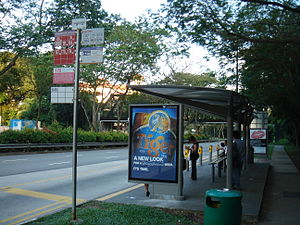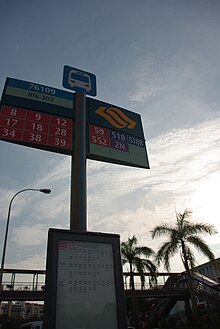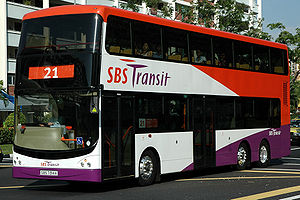Public buses of Singapore




Bus transport in Singapore is the most comprehensive and affordable means of public transport for the masses, with over two million rides taken per day on average on the buses of the two main public transport providers SBS Transit and SMRT Corporation. There are more than 300 bus services covering all parts of Singapore.
History
When Singapore first gained independence in 1965, the state of the public transport system was extremely unsatisfactory. Its capacity was inadequate to cope with the population, while the buses were old and slow. Furthermore, the system was beleaguered with frequent problems such as poor management and substandard services and quality.
The main bus operator was the Singapore Traction Company, plying routes in the city area. Apart from that, there were many small and individual Chinese private bus companies, each plying a small part of the rural and fringe areas of the island, with only a few routes each. Therefore a simple journey from the East to the West of the island could involve several bus transfers, and could last a few hours aboard noisy and rickety buses.
As Singapore Traction Company had a 30-year monopoly and had no direct competition, its services were usually substandard, while the small Chinese bus companies also had a shortage of resources and funds. Moreover, many bus companies had labour problems. There were quite a few cases of labour unrest. In the late 1950s, the situation deteriorated. Militant bus workers, manipulated by communist-controlled unions, resorted to strikes in a demand for better work conditions and pay. These work stoppages plagued the entire bus system into chaos.
A famous bus strike was the Hock Lee bus riots on May 12, 1955, where workers from the Hock Lee Amalgamated Bus Company began to go on strike. They were members of the Singapore Bus Workers' Union (SBWU) and were protesting against bad working conditions, long working hours and a low pay. Students from the Chinese Middle schools even came to join and support the strikers. The situation was so bad that in 1955, the Chinese bus companies were hit by a total of 57 strikes. In 1956, the 'Great STC Strike' lasted 146 days. The strikers crippled the country's transport system. The chaotic conditions usually left the commuters in a lurch.
It was in the early seventies that government stepped in to reorganize the bus system. Many small bus companies were amalgamated into three larger bus companies, namely the Amalgamated Bus Company Ltd, Associated Bus Services Pte Ltd, and the United Bus Ltd. They were grouped into three regional sectors. The STC continued its monopoly on the central area of Singapore.
Notwithstanding the reorganization, bus services still did not improve much. There were still frequent breakdowns, overcrowded buses, and irregular fare and route structures. During this time, the protectionism of the STC by the government was also removed. The STC could not cope with this new environment and closed down its operations due to large financial losses.
In 1973, The three main bus companies were merged into a one single organization. The new company formed from this merger was the Singapore Bus Service (the predecessor of SBS Transit), which came into operation in November 1973. It was hoped that this would create economies of scale and ultimately improve bus services.
The government mooted the idea of a second bus company in the early eighties. The idea was to provide some degree of competition to SBS. Therefore Trans-Island Bus Services Limited was formed on 31 May 1982, as the second major public bus operator. Trans-Island started operations on 3 April 1983.
Mr Ong Teng Cheong, the then Minister for Communications, remarked that "Each company will act as a natural impetus to enhance the performance and efficiency of the other in the spirit of healthy competition and in the process help bring about a better level of service."
In August 1994, the government announced the transfer of 17 SBS services to Trans-Island bus services. This was to help TIBS in its early years.

In 2001, Singapore bus service changed its name to SBS Transit Limited. This was to reflect its status as a multi-modal transport operator, as it had won the tender to operate the new North East Line and the Sengkang/Punggol Light Rapid Transit Lines.
In late 2001, Trans-Island became a subsidiary of the Singapore Mass Rapid Transit Corporation (SMRT). Trans-Island Bus Service was renamed as SMRT Buses Ltd on 10 May 2004. This continues till today.
There are plans to convert bus interchanges into being air-conditioned as opposed to the current open-air. So far, four bus interchanges have been converted into air-conditioned ones. The first of these is the Toa Payoh Bus Interchange which opened for services in 2002. The second is the Sengkang Bus Interchange which commenced passenger usage in 2003. The third is the Ang Mo Kio Bus Interchange which opened in 2007. The fourth is the Boon Lay Bus Interchange which opened in 2009. Upcoming air-conditioned bus interchanges include Choa Chu Kang, Clementi, Yishun and Serangoon.
Public bus companies
| Company | Routes | Fleet | Daily Trips |
|---|---|---|---|
| SBS Transit | 185 133 trunk 52 feeder |
2,582 | 2.34 million |
| SMRT Buses | 78 48 trunk 14 feeder |
863 | 661,595 |
| Bus-Plus Services | 59 |
Vehicles



Singapore's buses consist of single deck 12 metre long buses used by all operators, double decker and midi buses are used solely by SBS Transit and articulated (bendy) buses are used solely by SMRT Buses for the exception of two being used by SBS Transit. The two articulated buses of SBS Transit, namely SBS998Y (Volvo B10MA) and SBS999U (Mercedes-Benz O405G), have since been sold to New Zealand in March 2006.
Examples of buses currently used in Singapore are:
SBS Transit
- Current fleet
- Dennis Dart (Bodied by Duple Metsec)
- Dennis Trident 3 (Low-floor, bodied by Duple Metsec DM5000)
- Leyland Olympian 3-Axles (Bodied by Walter Alexander)
- MAN 18.240 HOCL-NL (Demonstrator - SBS8031J. Low-entry, bodied by Gemilang) (WAB)
- Mercedes-Benz O405 (Bodied by Walter Alexander & Duple Metsec)
- Volvo B10M-61 Mark III (Bodied by Duple Metsec)
- Volvo B10M-60 Mark IV (Bodied by Soon Chow, Duple Metsec & Walter Alexander)
- Volvo B10M-70 Mark IV "Superlong" (Demonstrator - SBS997A, bodied by Duple Metsec)
- Volvo Olympian 2-axle (Non Air-conditioned, bodied by Walter Alexander)
- Volvo Olympian 3-axle (Bodied by Walter Alexander)
- Volvo B9TL (Low-entry, bodied by ComfortDelgro Engineering and Wright Eclipse Gemini 2) (WAB)
- Volvo B10BLE (Demonstrator - SBS1688K. Low-entry, bodied by Volgren)
- Volvo B10TL (Demonstrator - SBS9888Y, SBS9889U. Low-floor, Bodied by Volgren & ComfortDelgro Engineering)
- Scania L94UB (Demonstrator - SBS2888T. Low-entry, bodied by Volgren)
- Scania K230UB (Demonstrator - SBS8033D. Low-entry, bodied by Gemilang) (WAB)
- Scania K310UD (Demonstrator - SBS7888K. Low-entry, bodied by Gemilang) (WAB)
- Volvo B7RLE (Demonstrator - SBS8030L. Low-entry, bodied by Soon Chow) (WAB)
- Volvo B7RLE (Demonstrator - SBS5253E. Deliveries commences in 2012 or 2013. Low-entry, bodied by MCV Evolution) (WAB)
- Mercedes-Benz Citaro (O530) (Demonstrator - SBS8029S. Bodied by Mercedes-Benz) (WAB)
- Mercedes-Benz OC500LE (Demonstrator - SBS8032G. Bodied by Gemilang) (WAB)
- Historical fleet
- Albion Viking
- Guy Victory
- Leyland Atlantean
- Leyland Olympian 2-axle
- Mercedes-Benz O305
- Mercedes-Benz O405G (Bodied by Volgren)
- Volvo B57
- Volvo B10M-61 Mark II (Bodied by Walter Alexander & Duple Metsec)
- Volvo B10MA-60 Mark IV (Bodied by Duple Metsec)
SMRT Buses
- Current fleet
- DAF SB220LT (Bodied by Walter Alexander)
- Mercedes-Benz O405 (Bodied by Hispano & Volgren)
- Scania L113CRL (Bodied by Walter Alexander & ELBO)
- Hino HS3KRKA/HS3KRKK (Demonstrator - TIB905Y. Bodied by Volgren)
- Mercedes-Benz O405G (Demonstrator - TIB838H. Bodied by Hispano)
- Mercedes-Benz O405GN (Demonstrator - TIB1024H. Bodied by Hispano & Volgren)
- Dennis Lance (UMW made, bodied by Duple Metsec)
- Dennis Lance (UK made, bodied by Duple Metsec and Volgren)
- Mercedes-Benz OC500LE (Demostrator - SMB1H. Low-entry, Bodied by Gemilang) (WAB)
- Yutong ZK6126 (Demonstrator - SMB135E. Bodied by Yutong) (WAB)
- Mercedes-Benz Citaro (O530) (Demonstrator - SMB136C. Deliveries ongoing. Bodied by Mercedes-Benz) (WAB)
- King Long XMQ6121G Hybrid (Demonstrator - SMB137A. Bodied by King Long) (Non-existent) (WAB)
- Scania K280UB (Demonstrator - SMB204P. Deliveries commences in 2011. Low-entry, bodied by Gemilang) (Non-existent) (WAB)
- Scania K280UA (Demonstrator - SMB570G. Deliveries commences in 2011 or 2012. Low-entry, bodied by Gemilang) (Non-existent) (WAB)
- Mercedes-Benz Citaro G (O530G) (Demonstrator - SMB891E. Deliveries commences in 2012. Low-entry, bodied by Mercedes-Benz) (Non-existent) (WAB)
- Volvo B7RLE (Demonstrator - SMB952M. Deliveries commences in 2012 or 2013. Low-entry, bodied by MCV Evolution) (Non-existent) (WAB)
- Historical fleet
- Hino HT238
- Nissan Diesel U31RCN (Bodied by Fuji Heavy Industries)
Routes

Singapore has many different bus services plying through the island. These bus routes can be grouped into the following categories:
- Trunk: Routes that ply between towns. These are the basic forms of bus services, found almost throughout the island.
- Short Trip: Routes that operate short haul trips which cater to high demand sectors of an entire trunk route, such as the area near an MRT station.
- Feeder: Services that operate within a neighbourhood, connecting outlying areas to the town centre or bus interchange.
- Intra-Town (SMRT Buses) and TownLink (SBS Transit): Routes that consist of combined feeder services to provide links and improve connectivity between neighbourhoods within the same town, and with the bus interchange and MRT.
- Jurong Industrial Service: Routes that service the Jurong and Tuas industrial areas.
- Express: Routes that stop at several nominated stops and generally run on expressways for faster travel between several towns.
- Fast Forward: A modification of trunk routes, Fast Forward are routes which provide faster travel between places where there is higher demand, by calling at fewer stops.
- NightRider (SMRT Buses) and Nite Owl (SBS Transit): After-hour services on Friday, weekends and eve of public holidays.
- Chinatown Direct: Routes that run from suburban towns to Chinatown via the expressways. Such routes are very popular in the period before the Lunar New Year.
- Parks: Services that run from major parks to the nearest bus interchange.
- Stadium Direct: Services that run from the Singapore Indoor Stadium to major towns after major concerts or events being held there. The Stadium Direct Services will no longer be offered from 1 September 2010.
- Premium: Services that run from major towns to Shenton Way, Orchard Road and Suntec City
- Resorts World at Sentosa: Services that run from major locations to Resorts World at Sentosa
Special bus routes that were recently terminated:
- CityBuzz: Citybuzz had 3 special bus services that looped Marina Centre, Orchard Road, Chinatown, and Little India, and were more orientated towards sightseeing and tourists. (No longer in service due to lack of demand.)
- CityShopper: Services that run from major towns to and from Orchard Road and Suntec City.
References
- Ilsa Sharp, (2005), SNP:Editions, The Journey - Singapore's Land Transport Story. ISBN 981-248-101-X
